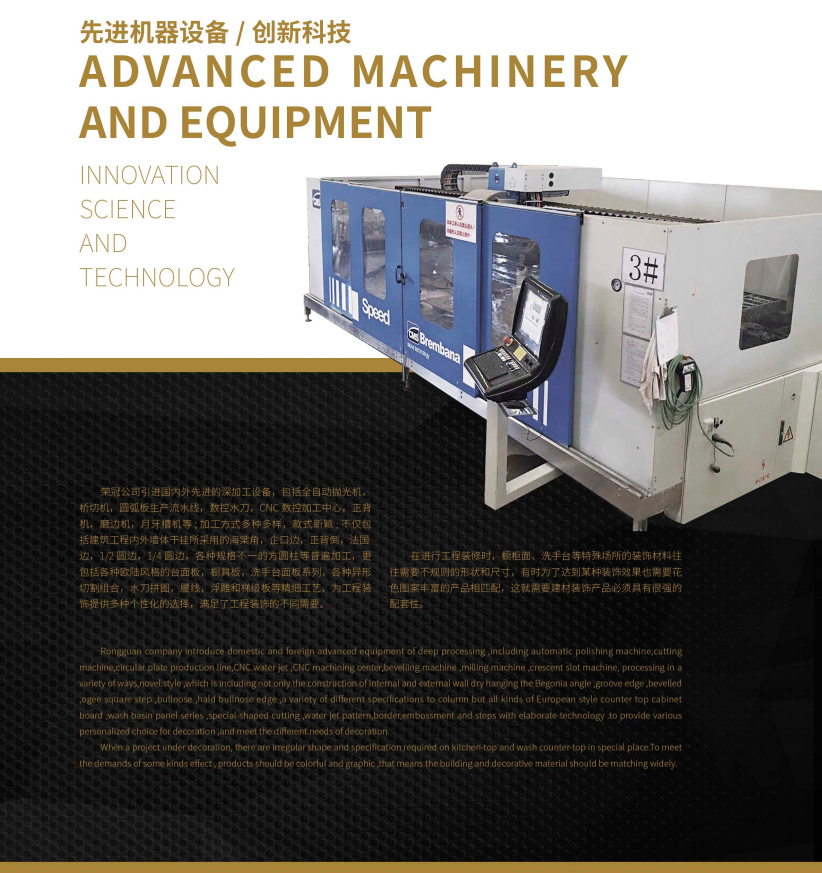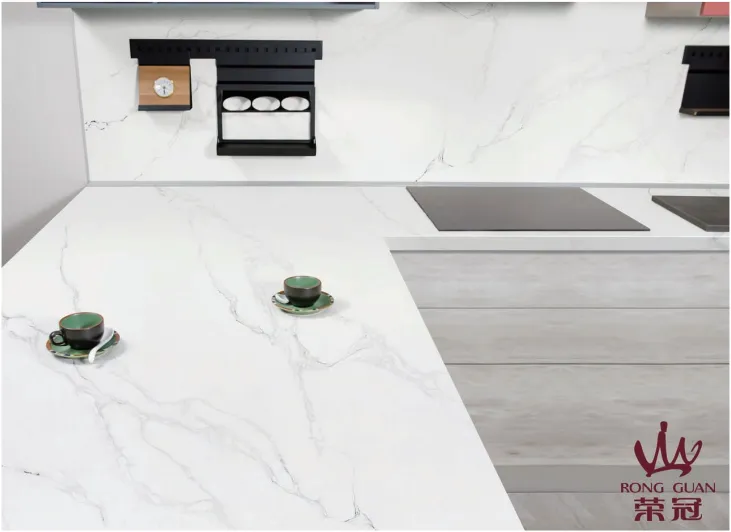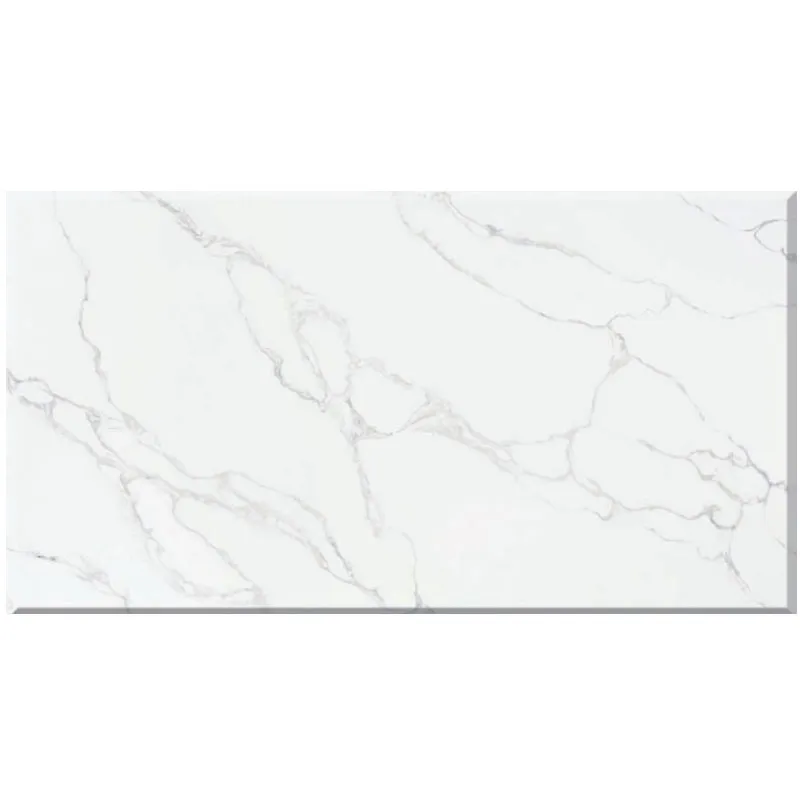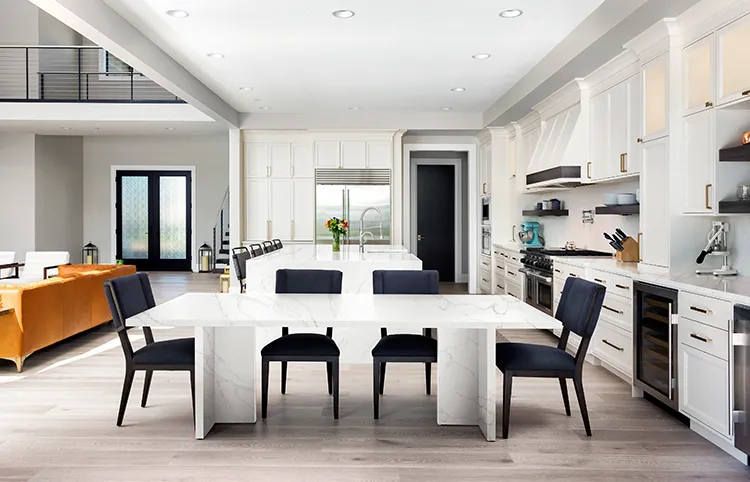In modern kitchen design, quartz kitchen countertops have become an important choice for many home decorations due to their high strength, corrosion resistance, stain resistance and easy cleaning. For users who pursue integrated aesthetics and high hygiene standards, another key question is often raised: Can quartz kitchen countertops be seamless?
This is a professional question involving multiple dimensions such as material structure, manufacturing process, and installation technology. This article will conduct in-depth analysis from multiple angles and systematically answer this question.

What material is quartz kitchen countertop?
Quartz kitchen countertops generally refer to artificial quartz stone countertops, the main component of which is natural quartz sand (SiO₂), supplemented with resin, pigment and a small amount of additives, and pressed into shape through vacuum, high pressure, vibration and other processes. Its typical composition ratio is roughly as follows:
• Quartz content: about 90%-93%
• Resin adhesive: about 7%-10%
• Other minerals, pigments, etc.: less than 3%
This material combines the hardness of natural stone with the plasticity of artificial manufacturing. It has excellent wear resistance, high temperature resistance, and anti-permeability, and is an ideal choice for kitchen use environments.

What is a "seamless" connection?
In the architectural decoration and home improvement industry, the term "seamless" is often misunderstood or generalized. Taking quartz kitchen countertops as an example, the so-called "seamless" actually has three levels of technical meaning:
• Visual seamless: no obvious seams or splicing marks can be seen by the naked eye, and the surface is continuous.
• Physical seamless: adhesives or hot melt processes are used at the joints to make the hardness and strength of the joints consistent with the original board.
• Structural one-piece molding: The entire countertop is processed from a whole piece of quartz stone board without any splicing or connection.
For the question of "Can quartz kitchen countertops be seamless?", most users are concerned about the first two, especially whether "seamless splicing" can be achieved in visual and physical sense through process processing.
Can quartz kitchen countertops really achieve "seamless splicing"?
1. Physical property limitations of quartz stone
Although quartz kitchen countertops have high hardness, their physical properties still have certain brittleness and thermal expansion and contraction characteristics because they contain resin and other fillers. Therefore, their size is limited, and large quartz kitchen countertops generally need to be made and transported in sections, which also makes it difficult for natural finished countertops to cover all areas of the kitchen in one piece.
In this case, multiple quartz stone slabs must be connected by splicing during installation, which involves "whether seamlessness can be achieved."
2. Application of artificial splicing technology
Currently, the following splicing processes are commonly used in the industry:
• Splicing polishing technology: Use quartz stone particles of the same color and special glue (such as AB glue) at the splicing joints, fill the joints, and then grind and polish them to make them consistent with the surrounding countertops.
• 45° beveled splicing: Through beveled technology, two panels are spliced with the minimum contact surface to visually reduce the gap.
• Hot melt bonding technology: Use resin hot melt adhesive to make the splicing part fuse after heating, and form a continuous structure after cooling.
In summary, from a technical perspective, quartz kitchen countertops can achieve a "near-seamless" effect, but it is not physically completely free of seams.

How does the quartz kitchen countertop perform after splicing?
Although it is impossible to achieve true "one-piece molding", quartz kitchen countertops with proper splicing still show extremely high practicality and aesthetic value in the following aspects:
1. Firm joints and stable structure
After using high-quality glue and professional splicing technology, the joints have high tensile strength and compressive strength, are not easy to crack or fall off, and their strength can be close to the original quartz plate itself.
2. Natural splicing effect, small color difference
Regular brands will use plates with consistent colors and batches for splicing, and through precision processing and polishing, the splicing lines are almost invisible under natural light and lighting, greatly improving the overall aesthetics.
3. Smooth surface and easy to clean
The polished and polished quartz kitchen countertops have smooth joints without obvious bumps or gaps, which are not easy to hide dirt and meet the high hygiene standards of the kitchen.
Scope of application of "seamless" splicing of quartz kitchen countertops
In practical applications with complex and changeable kitchen structures, quartz kitchen countertop splicing usually appears in the following locations:
• L-shaped kitchen corners
• U-shaped kitchen middle section connection
• Large-area workbench center splicing
• Sink and stove embedded area edge splicing
• Countertop and water retaining strip, back wall connection
In these locations, the use of "near-seamless" technology can effectively improve visual unity and the overall strength of the countertop.
Key factors in the splicing process of quartz kitchen countertops
The core of achieving high-quality seamless splicing lies in the following key points:
1. Plate cutting accuracy
Quartz kitchen countertops need to be processed by CNC cutting (such as CNC water jet) and the edges must be smooth to achieve perfect splicing.
2. Quality of adhesive
The color of the splicing glue must be consistent with the countertop and have strong anti-aging, anti-permeability and adhesion. Avoid using inferior glue to cause discoloration or cracking of the splicing seams.
3. Installation technology level
The level of the installer is the direct determining factor of the success of the splicing, including splicing pressure control, seam adjustment, on-site polishing, etc., requiring the worker to have rich experience.
4. Use environment control
The temperature and humidity during construction, dust control, and light during the splicing process will affect the splicing effect. Strict construction environment management is a necessary condition to ensure the quality of splicing.
Common misunderstandings about quartz kitchen countertops and seamlessness
In the perception of consumers, the following misunderstandings often occur:
Misunderstanding 1: Thinking that "seamless" means no gaps at all
In fact, most so-called "seamless" refers only to visual or physical seam processing, rather than one-piece molding.
Misunderstanding 2: Thinking that seams must be prone to cracking or mold
As long as regular brands and professional installation teams are used, the seams are usually stronger than natural boards, and there are no sanitary dead corners.
Misunderstanding 3: Blindly pursuing "a whole piece of quartz countertop"
Given that quartz kitchen countertops are heavy, difficult to transport and costly, a whole piece of processing is more likely to break during transportation, and segmented splicing is more stable, economical and practical.
Compared with other countertop materials, what are the advantages of quartz kitchen countertop splicing?
Compared with other common kitchen countertop materials, quartz kitchen countertops have obvious advantages in "seamless" splicing:
As can be seen from the above table, quartz kitchen countertops perform well in terms of aesthetics, stain resistance and splicing controllability. They are only slightly inferior to acrylic artificial stones in processing flexibility, but their overall performance is excellent.

Can quartz kitchen countertops be seamless?
The answer is: quartz kitchen countertops cannot achieve true structural seamlessness, but through modern splicing technology, they can achieve "near-seamless" effects in visual and physical senses. This treatment method not only meets aesthetic requirements, but also has good strength and cleaning convenience. It is one of the practical and high-end choices in current kitchen decoration.
| Material type | Splicing can achieve seamlessness | Stain resistance | Crack resistance | Aesthetics | Processing flexibility |
| Quartz kitchen countertops | ★★★★☆ | ★★★★★ | ★★★★☆ | ★★★★★ | ★★★☆☆ |
| Natural marble | ★★★☆☆ | ★★☆☆☆ | ★★☆☆☆ | ★★★★☆ | ★☆☆☆☆ |
| Stainless steel countertops | ★★★★★ | ★★★★☆ | ★★★☆☆ | ★★☆☆☆ | ★★☆☆☆ |
| Artificial acrylic countertops | ★★★★★ | ★★★★★ | ★★★★☆ | ★★★★☆ | ★★★★★ |
| Fireproof board countertops | ★★☆☆☆ | ★★☆☆☆ | ★★☆☆☆ | ★★☆☆☆ | ★★★☆☆ |
If consumers choose regular brands, professional construction teams, and reasonably plan the quartz kitchen countertop design according to the kitchen structure, the effect of the splicing can be completely comparable to the visual experience of "seamless one-piece molding", combining beauty and practicality.
Artificial stone countertops are currently the only material that can widely achieve true "seamless splicing" and are suitable for most spaces with high requirements for detail beauty and hygiene. Although quartz stone countertops have high hardness and stable performance, due to the physical limitations of the material, there will always be slight seams at the splicing, which cannot meet the truly seamless standards and can only be regarded as "quasi-seamless".

